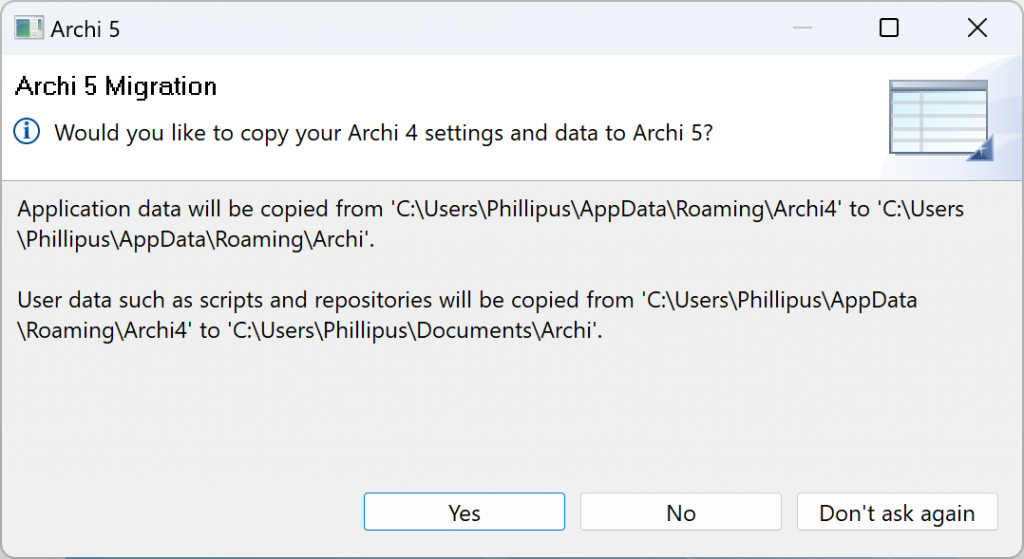We’re delighted to announce that Archi version 5 is now available to download. There are many new features, improvements and fixes in this release so please take a look at the full list of changes in the Version History.
Here’s a summary of some of the new features in Archi 5.
Support for ArchiMate 3.2
Archi 5 has support for ArchiMate version 3.2. This is a minor revision to the specification that changes some of the relationship rules, graphical representations of some of the elements (colours, figures, etc) and some other changes. Read about what’s changed here.
We’ve added new icons and alternate figures for many of the ArchiMate elements to match those in ArchiMate 3.2. Some of the relationship rules have changed so you might want to run Archi’s Validator to see if anything needs updating.
Archi data location
Archi 4 stores all of its data in a location depending on platform:
Linux: [home directory]/.archi4 Windows: [home directory]/AppData/Roaming/Archi4 Mac: [home directory]/Library/Application Support/Archi4
The problem is that for Windows and Mac users these folders are in parent folders that are hidden by default. So it can be a problem for some users to access their jArchi scripts, coArchi repositories and Jasper Reports templates. For Archi 5 we’ve decided to split application data and user data into two separate locations. Application data (preferences, UI state, plug-ins) will be stored in the following locations:
Linux: [home directory]/.archi Windows: [home directory]/AppData/Roaming/Archi Mac: [home directory]/Library/Application Support/Archi
And user data (jArchi scripts, coArchi repositories and Jasper Reports templates) will be stored in the following location for each platform:
[home directory]/Documents/Archi
This will also ensure that you can run Archi 4.x and Archi 5 simultaneously.
To ensure a smooth migration, when Archi 5 is first run it will check if the default Archi 4 folder exists and, if it does, offer to copy all the Archi 4 files to the new target folders.

New Secure Storage
In Archi 5 secure information such as passwords will be stored using Eclipse’s secure storage framework. This also means that a primary password does not need to be provided each time, as this is stored in the system’s keychain or credentials manager.
For now this new framework is only used for network proxy credentials but will be used for more things later (coArchi 2 and other plug-ins that are under development). coArchi 1 will continue to use its own mechanism for storing passwords.

Network Connections Preferences
You can now set network proxy settings here. This means that “Check for Updates” will work through a proxy. Note that coArchi 1 will continue to use its own mechanism for proxy settings.

Key Bindings Preferences
This has been requested for a long time. In Archi 5 you’ll be able to customise key bindings for various Archi commands.

Note that some key binding commands are not relevant to Archi and are present because of the underlying Eclipse framework. Examples of these are “Add Bookmark”, “Close Perspective”, “Content Assist” and several others. Should you accidentally invoke a command and Archi does not display or behave as expected, you can reset by selecting “Help -> Reset Archi to Defaults… -> Reset User Interface”.
This also means that jArchi 1.4 (coming soon) will have support for custom key bindings to run scripts.
Other Changes
Of course there are plenty more changes in Archi 5. The full list of changes in the Version History.
Thanks to Archi Supporters
And finally, we’d like to thank everyone who has supported Archi on Patreon and from other donations. Without this support Archi 5 would not have been possible.
